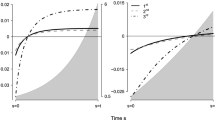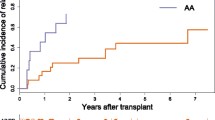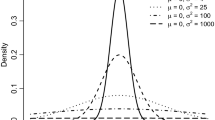Abstract
Competing risks occur in a time-to-event analysis in which a patient can experience one of several types of events. Traditional methods for handling competing risks data presuppose one censoring process, which is assumed to be independent. In a controlled clinical trial, censoring can occur for several reasons: some independent, others dependent. We propose an estimator of the cumulative incidence function in the presence of both independent and dependent censoring mechanisms. We rely on semi-parametric theory to derive an augmented inverse probability of censoring weighted (AIPCW) estimator. We demonstrate the efficiency gained when using the AIPCW estimator compared to a non-augmented estimator via simulations. We then apply our method to evaluate the safety and efficacy of three anti-HIV regimens in a randomized trial conducted by the AIDS Clinical Trial Group, ACTG A5095.


Similar content being viewed by others
References
Andersen PK, Borgan Ø, Gill RD, Keiding N (1993) Statistical models based on counting processes. Springer series in statistics. Springer, New York
Andersen JW, Fass R, van der Horst C (2007) Factors associated with early study discontinuation in AACTG studies, DACS 200. Contemp Clin Trials 28:583–592
Arici C, Ripamonti D, Maggiolo F, Rizzi M, Finazzi MG, Pezzotti P, Suter F (2002) Factors associated with the failure of HIV-positive persons to return for scheduled medical visits. HIV Clin Trials 3(1):52–57
Bender R, Augustin T, Blettner M (2005) Generating survival times to simulate cox proportional hazards models. Stat Med 24(11):1713–1723
Bryant J, Dignam JJ (2004) Semiparametric models for cumulative incidence functions. Biometrics 60(1):182–190
Dudley J, Jin S, Hoover D, Metz S, Thackeray R, Chmiel J (1995) The multicenter AIDS cohort study: retention after 9 1/2 years. Am J Epidemiol 142(3):323–330
Fine JP (2001) Regression modeling of competing crude failure probabilities. Biostatistics 2(1):85–97
Fine JP, Gray RJ (1999) A proportional hazards model for the subdistribution of a competing risk. J Am Stat Assoc 94(446):496–497
Fleishman JA, Yehia BR, Moore RD, Korthuis PT, Gebo KA, HIV Reseach Network (2012) Establishment, retention, and loss to follow-up in outpatient HIV care. J Acquir Immune Defic Syndr 60(3):249–259
Fleming T, Harrington D (1991) Counting processes and survival analysis. Wiley, New York
Gray RJ (1988) A class of K-sample tests for comparing the cumulative incidence of a competing risk. Ann Stat 16(3):1141–1154
Gulick R, Ribaudo H, Shikuma C, Lustgarten S, Squires K, Meyer W III, Acosta E, Schackman B, Pilcher C, Murphy R et al (2004) Triple-nucleoside regimens versus efavirenz-containing regimens for the initial treatment of HIV-1 infection. N Engl J Med 350(18):1850–1861
Gulick R, Ribaudo H, Shikuma C, Lalama C, Schackman B, Meyer W III, Acosta E, Schouten J, Squires K, Pilcher C et al (2006) Three-vs four-drug antiretroviral regimens for the initial treatment of HIV-1 infection. JAMA 296(7):769–781
Heitjan DF, Rubin DB (1991) Ignorability and coarse data. Ann Stat 19(4):2244–2253
Ioannidis JPA, Bassett R, Hughes MD, Volberding PA, Sacks HS, Lau J (1997) Predictors and impact of patients lost to follow-up in a long-term randomized trial of immediate versus deferred antiretroviral treatment. J Acquir Immune Defic Syndr Hum Retrovirol 16(1):22–30
Jeong JH, Fine J (2006) Direct parametric inference for the cumulative incidence function. J R Stat Soc Ser C (Appl Stat) 55(2):187–200
Kalbfleisch JD, Prentice RL (1980) The statistical analysis of failure time data. Wiley, New York
Krishnan S, Wu K, Smurzynski M, Bosch RJ, Benson CA, Collier AC, Klebert MK, Feinberg J, Koletar SL, ALLRT, A5001 team (2010) Incidence rate of and factors associated with loss to follow-up in a longitudinal cohort of antiretroviral-treated HIV-infected persons: an AIDS Clinical Trials Group (ACTG) Longitudinal Linked Randomized Trials (ALLRT) analysis. HIV Clin Trials 12(4):190–200
Lanoy E, Mary-Krause M, Tattevin P, Dray-Spira R, Duvidier C, Fischer P, Obadia Y, Lert F, Costagliola D, the Clinical Epidemiology Group of the French Hospital Database on HIV infection (2006) Predicators identified for losses to follow-up among HIV-seropositive patients. J Clin Epidemiol 59:829–835
Lin DY (1997) Non-parametric inference for cumulative incidence functions in competing risks studies. Stat Med 16(8):901–910
Lok JJ, Hughes MD (2016) Evaluating predictors of competing risk outcomes when censoring depends on time-dependent covariates, with application to safety and efficacy of HIV treatment. Stat Med 35(13):2183–2194
Pintilie M (2006) Competing risks: a practical perspective. Wiley, New York
Robins JM, Rotnitzky A, Zhao LP (1995) Analysis of semiparametric regression models for repeated outcomes in the presence of missing data. J Am Stat Assoc 90(429):106–121
Robins J, Rotnitzky A (1992) Recovery of information and adjustment for dependent censoring using surrogate markers. In: Jewell NP, Dietz K, Farewell VT (eds) AIDS Epidemiology (Methodological issues), Birkhäuser Boston, pp. 297–331
Rotnitzky A, Farall A, Bergesio A, Scharfstein D (2007) Analysis of failure time data under competing censoring mechanisms. J R Stat Soc Ser B (Stat Methodol) 69(3):307–327
Rotnitzky A, Bergesio A, Farall A (2009) Analysis of quality-of-life adjusted failure time data in the presence of competing, possibly informative, censoring mechanisms. Lifetime Data Anal 15(1):1–23
Rotnitzky A, Robins JM (2005) Inverse probability weighted estimation in survival analysis. In: Armitage P, Coulton T (eds) Encyclopedia of biostatistics, 2nd edn. Wiley, New York
Rubin DB (1976) Inference and missing data. Biometrika 63(3):581–592
Tsiatis AA (2006) Semiparametric theory and missing data. Springer, Berlin
Acknowledgements
The authors would like to thank Andrea Rotnitzky for her review and valuable comments on this paper. We are grateful to the ACTG for providing data used in the motivating application. This work was partially supported by Grants AI024643, AI068634, and AI007358 from the National Institutes of Health. The content is solely the responsibility of the authors and does not necessarily represent the official views of the National Institutes of Health.
Author information
Authors and Affiliations
Corresponding author
Ethics declarations
Ethical approval
Analysis of data from ACTG A5095 was approved by the Institutional Review Board of the Harvard School of Public Health. Informed consent was obtained from all individual participants included in the study.
Appendix
Appendix
Equation (3) is an unbiased estimating equation for \(F_{j}(t)\) since
The third equality follows from the fact that \(\mathbf {E}\left( \tilde{\varDelta } | \bar{V}_{T},T \right) = Pr[\tilde{\varDelta } = 1 | \bar{V}_{T}, T]\) which under our coarsening at random assumption equals \( \pi (\tilde{T}|\bar{V}_{\tilde{T}};\varLambda _{0})\). From this it is clear that Eq. (3) is an unbiased estimating equation for \(F_{j}(t)\).
One can use the results in Robins and Rotnitzky (1992) to prove that with one type of censoring the solution to
with
and \(b(u,\bar{V}_{u})\) the same as in Eq. (9), is a doubly robust, locally efficient estimator for \(F_{j}(t)\). Here, \(dM_{C}(u) = dN_{C}(u) - d\varLambda (u)\). In our situation, with multiple types of censoring, it is easy to show that \(dM_{C}(u) = \sum _{r=1}^{r*}dM_{C,r}(u)\), which leads to our augmentation term in (8). Note that with one type of failure and one type of censoring, our method reduces to that of (Rotnitzky and Robins 2005).
Now, it can be shown that for each r, since
is a bounded and predictable process, defined on the same filtration as \(M_{C,r}(u)\),
is a mean zero martingale Fleming and Harrington (1991, Thm 1.5.1). Note that the left-continuous versions of \(b(u,\bar{V}_{u})\) and \(\pi (u|\bar{V}_{u};\varLambda _{0}(u))\) are needed here. As a result
is also a mean zero martingale. Thus, \(A_{i}\{F_{j}(t),\gamma ,b(\cdot )\}\) has mean zero. Since \(A_{i}\{F_{j}(t),\gamma ,b(\cdot )\}\) has mean zero, it also follows trivially that Eq. (7) is an unbiased estimating equation for \(F_{j}(t)\).
Rights and permissions
About this article
Cite this article
Lok, J.J., Yang, S., Sharkey, B. et al. Estimation of the cumulative incidence function under multiple dependent and independent censoring mechanisms. Lifetime Data Anal 24, 201–223 (2018). https://doi.org/10.1007/s10985-017-9393-4
Received:
Accepted:
Published:
Issue Date:
DOI: https://doi.org/10.1007/s10985-017-9393-4




